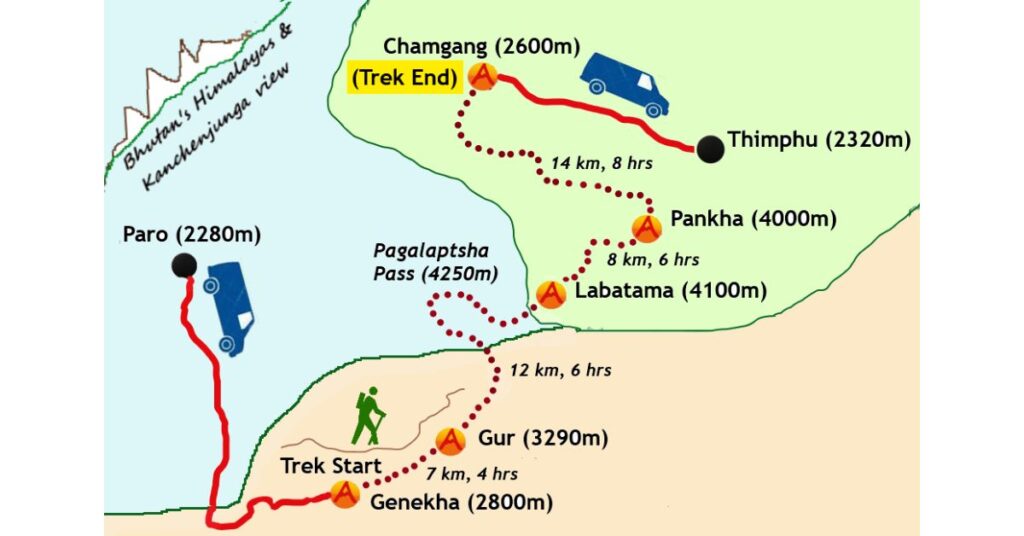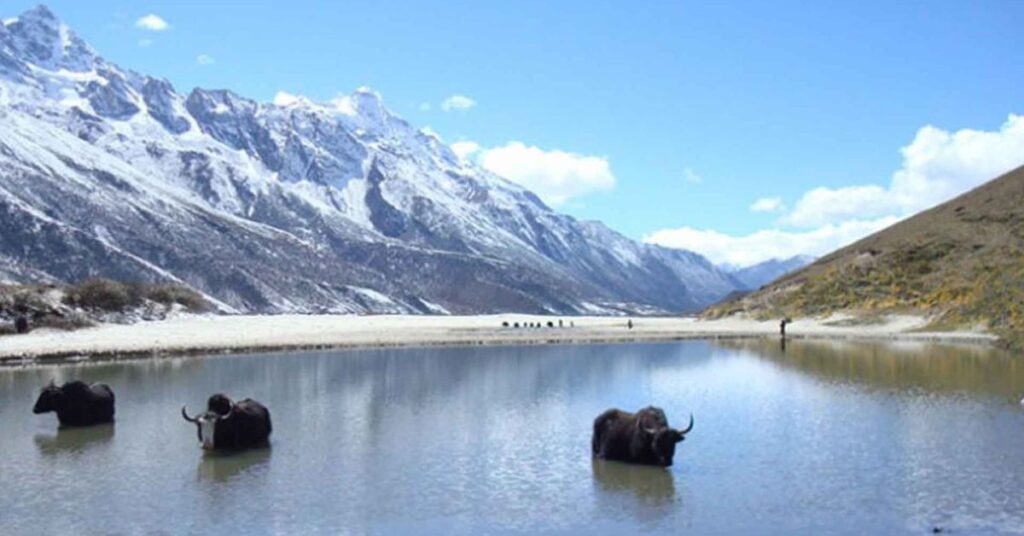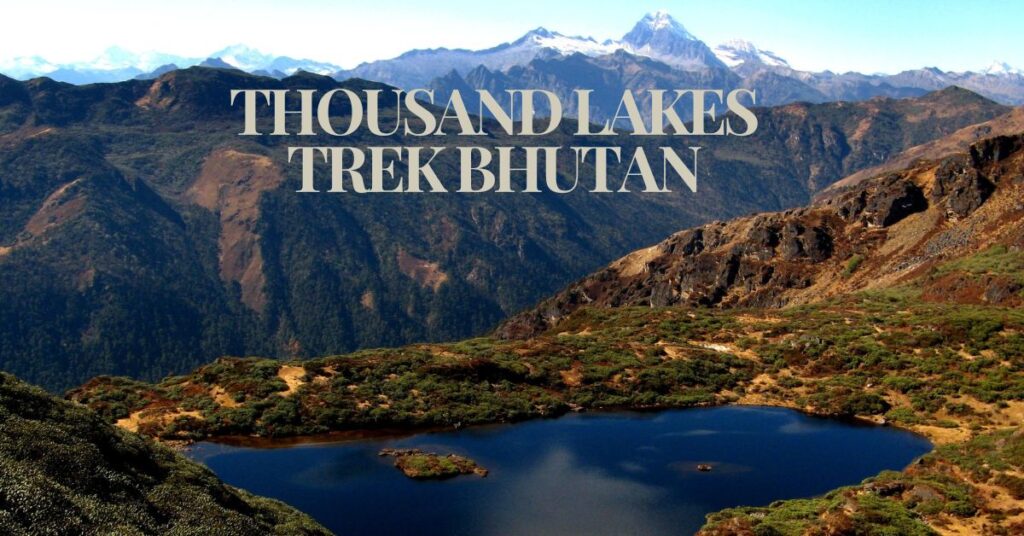The Thousand Lakes Trek Bhutan, often called the Dagala Thousand Lakes Trek, is one of Bhutan’s hidden gems. Tucked away in the remote wilderness of the Bhutanese Himalayas, this trek offers breathtaking views, serene glacial lakes, and a chance to experience the untouched beauty of nature. If you’re seeking an off-the-beaten-path adventure, this trek promises solitude, stunning landscapes, and a deep connection with the natural world.
Trek Overview
Trek Route:
The Dagala Thousand Lakes Trek begins in Genekha Village and leads you through a breathtaking journey across Bhutan’s mountainous landscape. The route weaves through green forests, alpine meadows, and rugged ridgelines, providing panoramic views of the surrounding peaks. As you trek, you will encounter several stunning high-altitude lakes, including:
- Utsho Tsho Lake: Known for its striking aquamarine waters and abundant golden trout, it’s a highlight of the trek.
- Relitsho Lake: Surrounded by vibrant wildflowers in spring, adding a splash of color to the peaceful landscape.
- Setsho, Hentsho, and Jagetsho Lakes: These additional lakes, located in the Labatama Valley, offer spectacular scenery and opportunities for trout fishing.
The trek will also take you past Dala Tsho Lake, where you can enjoy panoramic views of several prominent peaks including Mt. Everest, Mt. Kanchenjunga, and Mt. Jumolhari.
Trek Duration:
The Dagala Thousand Lakes Trek typically spans 7 to 8 days, depending on the pace of trekking and specific route adjustments. Each day involves approximately 5 to 7 hours of trekking, covering diverse terrain and including:
- Day 1: Arrival at Paro and exploration of local landmarks.
- Day 2: Hike to Tiger’s Nest Monastery and transfer to Thimphu.
- Day 3: Trek from Genekha to Gur (7 km).
- Day 4: Trek from Gur to Labatama (12 km).
- Day 5: Exploration and adaptation at Labatama, visiting various lakes.
- Day 6: Trek from Labatama to Panka (8 km).
- Day 7: Trek from Panka to Chamgang, followed by a drive to Thimphu (14 km).
- Day 8: Drive from Thimphu to Paro and final departure.
Difficulty Level:
The trek is considered moderately challenging with a mix of steep ascents and descents. It requires a good level of fitness and trekking experience, but the spectacular landscapes and serene lakes make the effort rewarding.

Dagala Thousand Lakes Trek – 8 Days Detailed Itinerary
Day 1: Arrival at Paro
Your adventure begins as you arrive at Paro International Airport, Bhutan’s only international entrance. You will go to your hotel in Paro. After checking in, you’ll have a chance to explore the town. Visit the Rinpung Dzong, a majestic Buddhist monastery built in the 15th century, known for its historical significance and stunning architecture. Follow this with a visit to Kichu Lhakhang, a revered Buddhist temple with a rich history. Spend your evening strolling through Paro’s charming streets, surrounded by traditional Bhutanese architecture.
Activities:
- Arrival at Paro International Airport.
- Visit Rinpung Dzong, a 15th-century Buddhist monastery.
- Explore Kichu Lhakhang, a historic Buddhist temple.
- Stroll through Paro’s traditional streets.
- Overnight: Hotel in Paro.
Day 2: Hike to Tiger’s Nest Monastery and Transfer to Thimphu
After breakfast, go on a hike to the iconic Tiger’s Nest Monastery (Paro Taktsang), perched dramatically on a cliff. This sacred site, where Guru Rimpoche meditated, offers panoramic views and a deep connection to Bhutanese spiritual heritage. The hike takes 5 to 6 hours, offering a blend of challenging paths and breathtaking scenery. After your visit, transfer to Thimphu, Bhutan’s capital. Enjoy an evening in this vibrant city, exploring its unique blend of modernity and tradition.
Activities:
- Hike to Tiger’s Nest Monastery (5 to 6 hours, 4 to 5 km round trip) for spectacular cliffside views.
- Transfer to Thimphu, Bhutan’s vibrant capital city.
- Overnight: Hotel in Thimphu.
Day 3: Trek from Genekha to Gur (3290m/10,793ft) – 7km, 5 to 6 Hours
Start your trek early in the morning with a drive to Genekha Village, renowned for its matsutake and chantarelle mushrooms. The trek begins with a descent to a river, followed by an ascent through terraced fields and coniferous forests. Reach the Gur campsite, set amidst yak pastures, after a scenic hike. Enjoy the picturesque views and wildflowers that adorn the trail.
- Trek Distance: 7 km (4.3 miles)
- Altitude: 2,900m to 3,290m (9,514ft to 10,793ft)
Activities:
- Drive to Genekha Village (45 minutes).
- Trek through terraced fields and coniferous forests.
- Arrive at Gur campsite amidst yak pastures and wildflowers.
- Overnight: Camp in Gur.
Day 4: Trek from Gur to Labatama (4,300m/14,107ft) – 12km, 6 to 7 Hours
Today’s trek takes you across high ridges and rugged terrain. You’ll cross the Paga Labsta Pass at 4,250m, offering spectacular views of Mt. Kanchenjunga and the Dagala mountain range. Continue your descent to Labatama Valley, where you’ll find the turquoise Utsho Tsho Lake. This lake, famous for its golden trout, provides a beautiful setting for your campsite.
- Trek Distance: 12 km (7.5 miles)
- Altitude: 3,290m to 4,300m (10,793ft to 14,107ft)
Activities:
- Trek across high ridges and the Paga Labsta Pass (4,250m).
- Descend into Labatama Valley.
- Camp beside Utsho Tsho Lake.
- Overnight: Camp in Labatama.
Day 5: Explore and Acclimatization at Labatama
Spend a day exploring Labatama and acclimating to the altitude. Visit the nearby lakes—Relitsho, Setsho, Hentsho, and Jagetsho—known for their clear waters and abundant trout. Enjoy a relaxing day by the lakeside, soaking in the serene beauty and engaging in some fishing if you wish. Your guide will share local myths and stories about these lakes, adding to the experience.
Activities:
- Explore Labatama’s lakes: Relitsho, Setsho, Hentsho, and Jagetsho.
- Engage in trout fishing and enjoy lakeside views.
- Acclimatize to the altitude and enjoy the serene environment.
- Overnight: Camp in Labatama.
Day 6: Trek from Labatama to Panka (4,000m/13,123ft) – 8km, 5 to 6 Hours
Start your day with a climb along the western side of Dala Tsho Lake, reaching an altitude of 4,520m for stunning panoramic views of Himalayan peaks, including Mt. Everest and Mt. Kanchenjunga. Descend through yak herder huts and follow the Doccha Chhu River to Panka. This section of the trek offers diverse landscapes and views of Bhutan’s majestic mountains.
- Trek Distance: 8 km (5 miles)
- Altitude: 4,300m to 4,000m (14,107ft to 13,123ft)
Activities:
- Climb along Dala Tsho Lake (4,520m) for panoramic views.
- Descend through yak herder huts and follow the Doccha Chhu River.
- Arrive at Panka campsite.
- Overnight: Camp in Panka.
Day 7: Trek from Panka to Chamgang and Drive to Thimphu – 14km, 7 to 8 Hours
On your final trekking day, cross several passes, including the Tale La Pass at 4,180m. Along the way, you’ll see Bhutan’s national flower, the Himalayan Blue Poppy. Visit the 15th-century Talakha Goempa and continue to Chamgang village. From Chamgang, drive to Thimphu. Spend the evening exploring the capital’s vibrant streets and local markets.
- Trek Distance: 14 km (8.7 miles)
- Altitude: 4,000m to 3,080m (13,123ft to 10,104ft)
Activities:
- Trek through various passes, including Tale La Pass (4,180m).
- View the Himalayan Blue Poppy and visit Talakha Goempa (15th century).
- Drive to Thimphu and explore the city’s modern and traditional sites.
- Overnight: Hotel in Thimphu.
Day 8: Drive from Thimphu to Paro and Final Departure
After breakfast, drive back to Paro. Reflect on your trek as you head to Paro International Airport for your departure. As you board your flight, take one last look at the stunning landscapes of Bhutan, from the lakes at Labatama to the majestic mountain peaks.
Activities:
- Drive back to Paro.
- Depart from Paro International Airport, reflecting on your trek.

Cultural and Natural Highlights
Key Lakes
- Utsho Lake: This is one of the largest and most beautiful lakes on the trek. It’s known for its deep blue color and the reflection of the surrounding peaks on its surface.
- Relitsho Lake: A smaller but equally stunning lake, surrounded by lush meadows and wildflowers. It’s a peaceful spot perfect for camping and soaking in the beauty of the Bhutanese wilderness.
Flora and Fauna
The trek takes you through diverse ecosystems, from temperate forests filled with rhododendrons and pine trees to high-altitude meadows where yaks graze. You may also spot various wildlife, including blue sheep, Himalayan monal pheasants, and even the elusive snow leopard if you’re very lucky.
Local Communities
While the trek is mostly through remote wilderness, you’ll pass by a few small villages where you can interact with local communities. The villagers are known for their hospitality, and you may have the chance to learn about their way of life, which remains closely connected to the rhythms of nature.
Practical Information
Cost Breakdown
The cost of the Thousand Lakes Trek can vary depending on several factors, such as whether you’re traveling with a tour group or independently. Here’s a basic breakdown of the costs:
- Permits: Bhutan requires all visitors to obtain a visa and pay a daily tariff, which includes accommodation, meals, and a licensed guide. The daily tariff is around $100-$120 per person, depending on the season.
- Guides and Porters: Hiring a guide and porter is highly recommended for this trek. The cost of a guide is included in the daily tariff, but you may need to pay extra for a porter, usually around $10-$15 per day.
- Camping Gear: If you’re not joining a tour, you’ll need to bring or rent your camping gear. Renting gear in Bhutan can cost around $50-$100 for the trek.
Best Time to Trek
The best time to undertake the Thousand Lakes Trek is from late April to early June or from September to early November. During these periods, the weather is generally clear, offering the best views of the lakes and mountains. The spring season brings blooming wildflowers, while autumn offers crisp air and vibrant fall colors.
Permits and Regulations
All trekkers must obtain the necessary permits before starting the trek. This includes the standard visa and daily tariff required for all visitors to Bhutan. Additionally, specific trekking permits are needed, which are typically arranged through your tour operator.
Guides and Porters
Guides are mandatory for all treks in Bhutan, as part of the government’s policy to preserve the environment and cultural heritage. Porters are not required but can be helpful, especially if you’re carrying heavy gear. Hiring a local guide not only enhances your trekking experience with valuable insights but also supports the local economy.

Tips for Trekkers
Packing List
- Clothing: Layers are key. Bring moisture-wicking base layers, a warm fleece, a down jacket, and waterproof outer layers.
- Camping Gear: A good-quality tent, a sleeping bag (rated for sub-zero temperatures), and a sleeping mat are essential.
- Footwear: Sturdy, waterproof trekking boots with good ankle support are a must.
- Other Essentials: Trekking poles, a first-aid kit, a headlamp, and enough snacks for energy boosts.
Preparation Tips
- Physical Fitness: This trek requires a moderate level of fitness. Regular hiking and cardio exercises are recommended in the months leading up to your trip.
- Adaptation: Spend a day or two adapting in Bhutan before starting the trek to reduce the risk of altitude sickness.
Safety Precautions
- Altitude Sickness: Be aware of the symptoms and take your time to adapt. Stay hydrated and avoid alcohol.
- Weather Changes: The weather can change rapidly in the mountains, so always be prepared with appropriate gear.
- Wildlife: While encounters with wildlife are rare, it’s important to keep a safe distance and avoid feeding animals.
Closing Words
The Thousand Lakes Trek Bhutan is more than just a hike; it’s an immersive experience that offers trekkers a rare opportunity to connect with Bhutan’s pristine natural beauty. From the soothing glacial lakes to the majestic peaks of the Himalayas, every step on this trek is a journey into the heart of Bhutan’s wilderness. With the detailed information and tips provided, you’re well-equipped to go on this unforgettable adventure. Whether you’re an experienced trekker or a nature enthusiast, the Thousand Lakes Trek promises memories that will last a lifetime.
The Thousand Lakes Trek typically takes 5 to 6 days, depending on the route and pace.
The best time to trek is from late April to early June or from September to early November.
Yes, permits are required, including a visa, daily tariff, and specific trekking permits.
Yes, guides are mandatory, and porters are available for hire.

